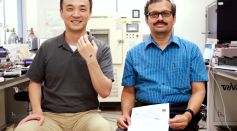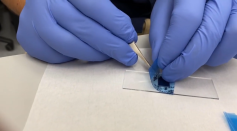Tags: Graphene
New Polymer Flexible Film Shields from Electromagnetic Radiation and Interference

Researchers Fabricate Novel X-Ray Photodetectors by Embedding Perovskites on Graphene
Nano-Origami Leads to Smallest ICs to Date
Vibrating 2-D Materials Could Revolutionize Electronics

Physicists Create Tunable Superconductivity in Nanosandwhich of Twisted Graphene
Magic-Angle Twisted Graphene Could Play Host to New Phases of Matter

Supercapacitor Development Makes Them Worthy Challengers to Batteries

Scientists Develop a Micro-Supercapacitor Made of Graphene Ink

Physicists Develop Nano-Sized SQUID Capable of Detecting Extremely Faint Magnetic Fields
Ultraclean Graphene As High Performance Magnetic Field Sensors

Self-Sterilizing Graphene Filter Effectively Eliminates Airborne Bacteria
A New Member of the Carbon Family is Born
Superlubricity Simulation in the Laboratory, Believed to Cut Down Energy Loss
Millions With Neurological Diseases Could Find New Option in Neurostimulation Devices
Using Graphene and Tiny Droplets to Detect Stomach-Cancer Causing Bacteria
Laser Technique Could Unlock Use of Tough Material for Next Generation Electronics
Battery-like Devices Could Be Woven Into Clothes Directly Thanks to Nanotechnology
Substrate Defect Crucial for Growth of 2D Materials
How Hydrogen Atoms Chemically Bind to Graphene in One of the Fastest Reactions Ever Studied
New Graphene Artworks Used Laser-Induced Graphene Instead of Ink
Most Popular

Why Stars Twinkle: Flickering Explained by Atmospheric Turbulence and Light Distortion

The Role of Materials Science in Engineering: How Modern Engineering Materials Drive Innovation

Tornadoes vs. Waterspouts vs. Dust Devils: Key Differences and Vortex Types Explained

Climate Adaptation Strategies Explained: How Societies Respond to Climate Change





